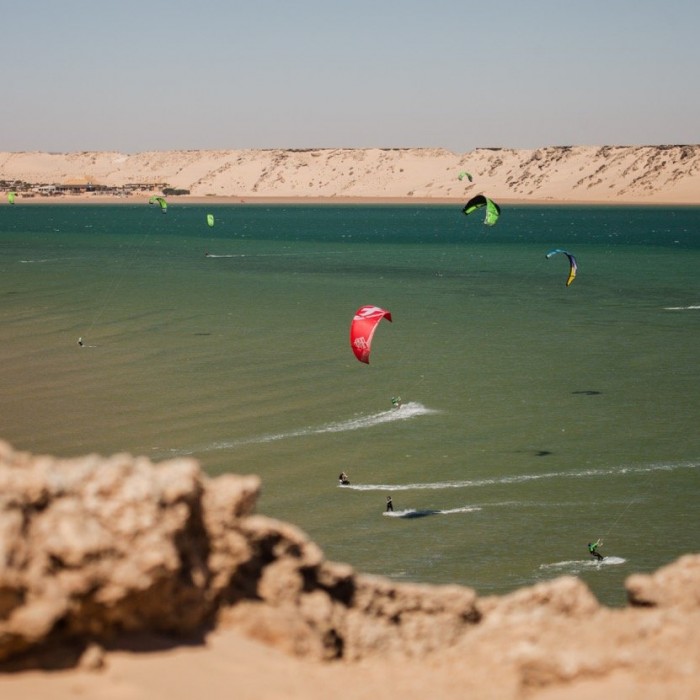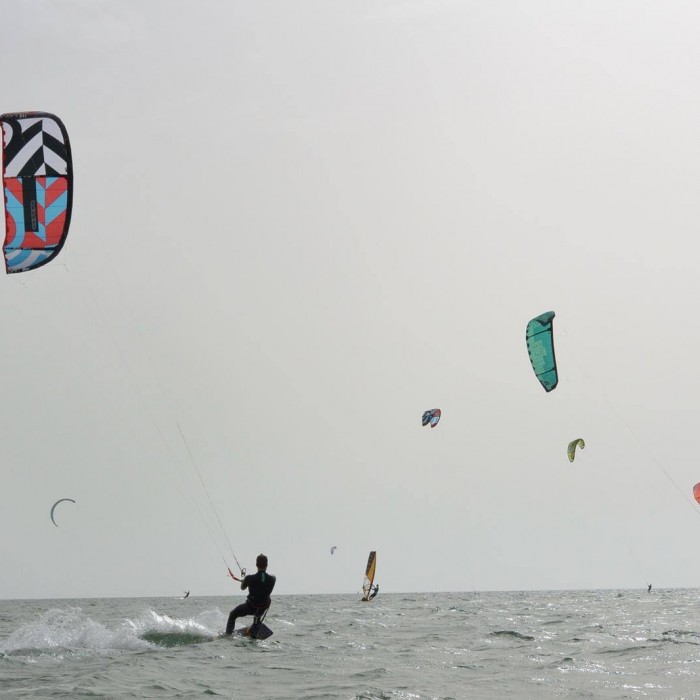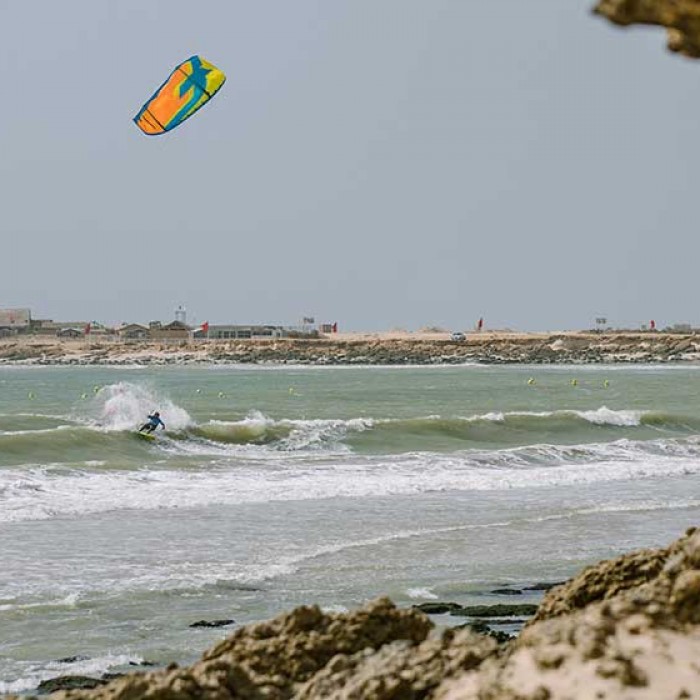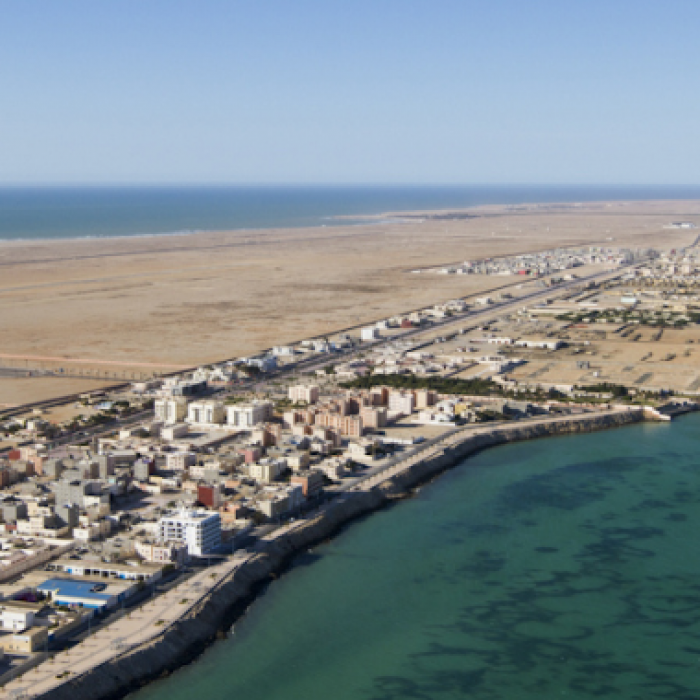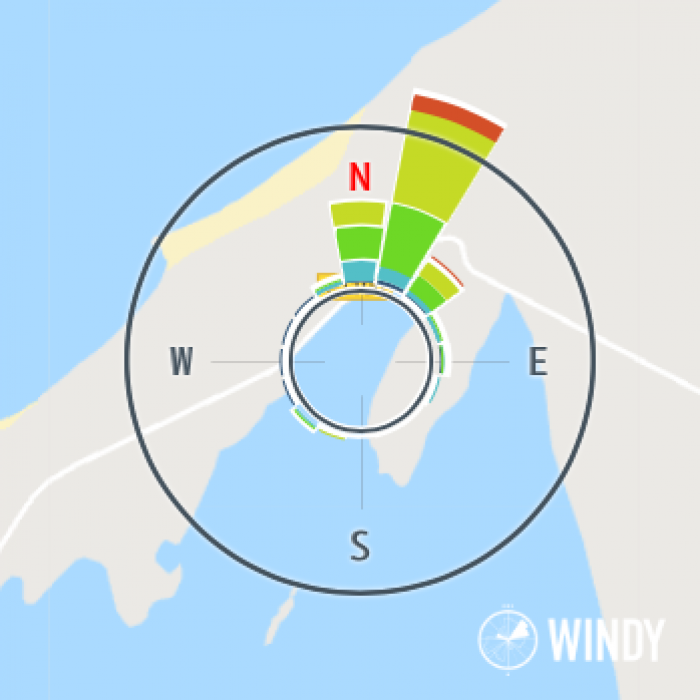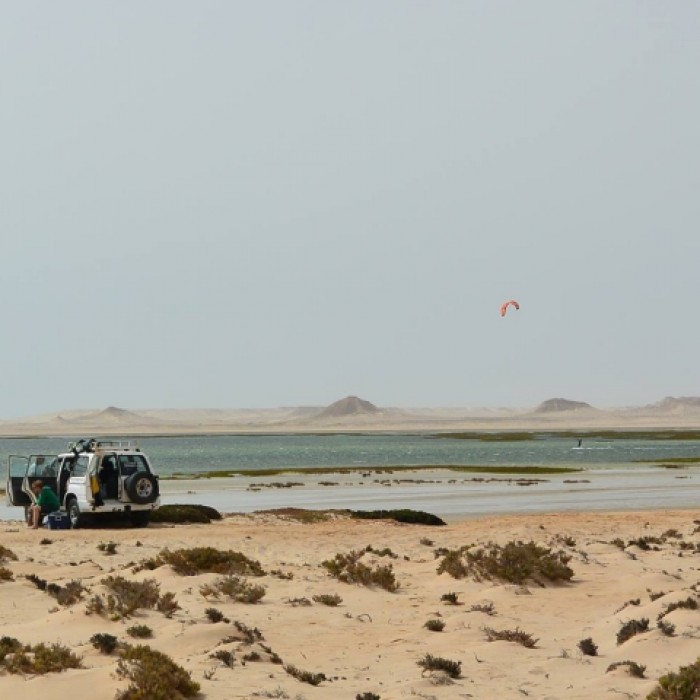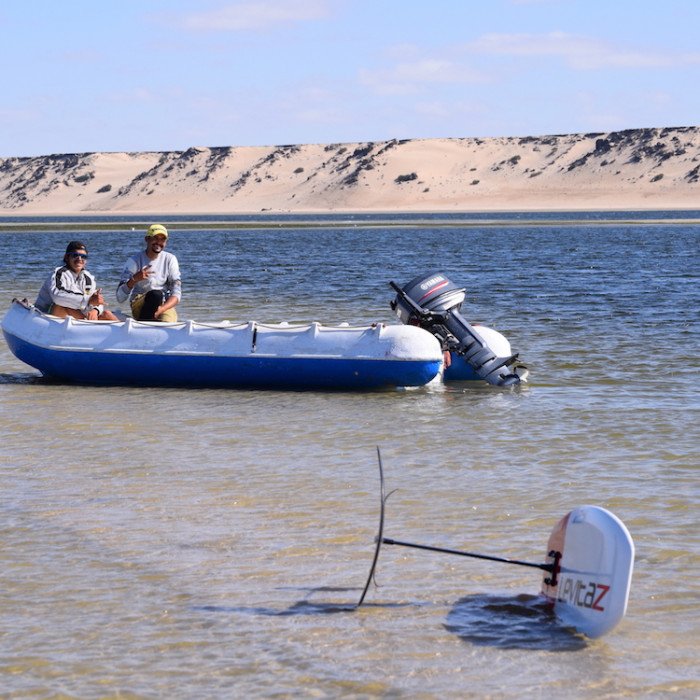Kitesurf at Dakhla
Exclusively for kitesurfers
- Overview
- Good to know
- Getting there
Overview
Dakhla is a city built on a peninsula that runs down from the mainland western Sahara and is located 400 kilometres north of the Mauritanian border. The position of the lagoon creates a perfectly sheltered flat water lagoon that stretches for approximately 45km and is 4+km wide. Endless shallow water freestyle playground, warm temperatures and wind all year round, makes this place a true kiteboarders paradise. And to top it all up, the Atlantic Ocean side of the peninsula offers some epic wave spots too. The main kitesurfing camps and the kite spots are located approximately 30 min drive from the main town, so if you choose to stay in guest houses in Dakhla town, you may want to consider renting a car. Most kitesurfers decide to stay in one of many all-inclusive kite camp-style accommodations directly at the spots, with all amenities explicitly created for kitesurfers. Accommodation ranges from budget to higher end, depending on your needs, but all of them will make sure you are well looked after and will be able to organise transfers to town and offer excursions to wave spots and arrange plenty of no wind activities if you wish so. If you venture to Dakhla Town itself, you can expect to meet many friendly and helpful locals, and you can explore their famous markets and try some of the local food. Dakhla is well known for its seafood; a trip to a local oyster farm at the edge of the lagoon is highly recommended. Dakhla is a watersports enthusiasts paradise. You’ll not be left wanting for things to do and you’ll hear many recommendations when you are there. You can expect trips to thermal Sulfur spring, 4x4 drives to wave spots and kite boat trips to the "White Dune”, ‘Speed Spot’ & ”Dragon Island” as well as multiple options for downwinders. For a not windy day, you can go paddleboarding, surfing or visit a cable park in Dakhla Attitude Camp.
Good to know
VISAS: Visas are not generally required for stays up to 90 days. More information can be found in this guide. CURRENCY: EUR, or MAD PRICES: Beer: €5 Food: Lunch €8-12 Accommodation: €10-100 pp Kite Lessons: 2H €60 Kite Gear rental: €40 half day LANGUAGE: French, Arabic and Spanish INTERNET: Wifi provided in accommodations, just remember that you are in the desert, so the connection is not always strong. If possible, we recommend getting a Local SIM card. TRAVEL ADVICE: Check this Lonely Planet guide for detailed health and insurance advise while traveling to Dakhla, Morocco. Don’t bring your drone to Morocco unless you have a special permit, it will be seized at the airport, and you will be fined. Moroccan Dirham is a closed currency. Therefore, you can only exchange in Morocco. Make sure that if you want to exchange some leftover bills, you do it before you go through security in the airport when leaving the country. TEMPERATURE: Due to the desert climate, the air temperature can reach 20 - 30°C / 68 - 86°F during the day and can drop to 12-15°C / 55-60°F in the evenings. There is plenty of sunshine all year round, and the weather is warm, but a sweater/jacket and a pair of jeans will come in handy after sunset and in windier days.
Getting there
NEAREST TOWN: Dakhla NEAREST CITY: Dakhla NEAREST AIRPORT: Dakhla airport [VIL] FLY - The easiest way is to take a local flight to Dakhla from Casablanca [CMN] or Agadir [AGA]. International flights also come from Las Palmas [LPA] and Paris [ORY] (not as regularly and depending on the season). BUS - The Moroccan transport company, CTM (www.ctm.ma), guarantees daily bus roundtrips from Agadir and Marrakesh. This represents a longer trip, but it can also be a good alternative to visit other places in the country. RENTAL - A rental car would take you around 16H to drive there from Agadir and allows you to move freely around Dakhla. GETTING AROUND: As the resorts are all based outside of the city and in more isolated areas, a rented car would be advisable for those wanting to explore the peninsula on their own. Please note, that some more rural locations will need a 4x4 and may not be easily found without a local guide. Additionally, most of the accommodation providers will be able to organise transfers to town, to offer tours and kitesurfing trips.
- Beach
- Wind
- Rules/Hazards
Beach
Soft-sand dunes in the deserted strip of Dakhla peninsula provides flat and shallow water closer to the bank, and small kickers (formed by the wind) as you go further away from the beach is a general set-up all around the lagoon. At the low tide, water depth is in standing range for around 300m from the beach, making it perfect practice ground for beginners and flat water lovers. In high-tide, the water gets deeper straight from the water's edge, but you can find some shallow water entrances depending on the position of the spot/camp you chose to kite from. Other spots in the lagoon consist of ‘Speed Spot’ for butter flat water action and downwinders to ‘White Dune’ (takes around 3h) that are organised almost daily from various camps and centres. At the Atlantic side of the peninsula, many great surf spots can be found. Generally swell is quite good all year round but the best waves come in September to May. Most schools will provide guided kitesurfing/surfing trips to Point De l’Or, Jorf El Hmam, and La Sarga plus many other beautiful surf spots dotted around the coast. Alternatively, some camps are permanently based in wave spots like Oum Lamboiur/Westpoint. AMENITIES: Kite School, Gear Rental, Rescue boat, Beach Assistance, Gear Storage, Kite Shop, Toilets, Shower, Parking, Camping, Cafe/Bar, Accommodation.
Wind
The trade winds from the Canaries and Cape Verde sweep over Dakhla throughout the year offering an average of 320 windy days. Those north-east trade winds blow side-shore from the right and are further accelerated by the mountains in the interior, as the wind funnels through them. The average wind speed is 15 to 25 knots, but in summer months you can add around 5 to 10 knots to the forecast due to the accelerated trade winds. The wind usually starts of lighter in the morning, peaks around midday and blows till sunset. If riding in the wave spots at the Atlantic Ocean side, consider that the wind will be generally light. The most used kites 8m to 12m sometimes 14m. The best months for the strong trade winds are during the summer of May till October; the best time for the winds and swell is October till March. Water temperatures averages 19 – 24°C / 59 - 71°F all year round, so a shortie or 3/2 will suffice for the most of the year. For the windy days and in colder months of January and February long wetsuit is recommended. WIND DIRECTIONS: N, NNE, NE WINDIEST SEASONS: High Season: April, May, June, July, August, September, October. Mid Season: November, December, January, February, March.
Rules/Hazards
There are no such rules, just a common sense - the beach area is relatively large. Therefore, the usual precautions when launching and landing the kite should be considered. Neoprene boots are recommended for the beginners, due to bits of sharp shell found at the beach. If you are not staying in any of the resorts nearby, it is recommended to get a rescue voucher from a local school. *If you need kite related service like kite repairs, lessons or beach assistance please contact with the local operating kite centre or camp. ** We always recommend seeking additional knowledge about the spot from local kite school and qualified instructors.

Info
Rider Level:
- beginner, intermediate, advanced
Discipline:
- freeride, waveriding, foiling
Spot Type:
- Flatwater, Lagoon
Launch area:
- Sand
Tidal:
- yes
Windiest Months:
- Jan, Feb, Mar, Apr, May, Jun, Jul, Aug, Sep, Oct, Nov, Dec
Around Dakhla
Things to do
The reviews say it all
spot reviews
Dakhla
GREAT KITESURFING DESTINATION, WITH A LOT OF SPOTS TO CHOOSE FROM ONCE THERE.
Lots to do
Never a dull moment. So many places to kite. I loved the perfect flat water at the speed spot.
Rating Summary
The latest shots
photo gallery
You’ve read all about it, now feast your eyes on your next kiting destination.

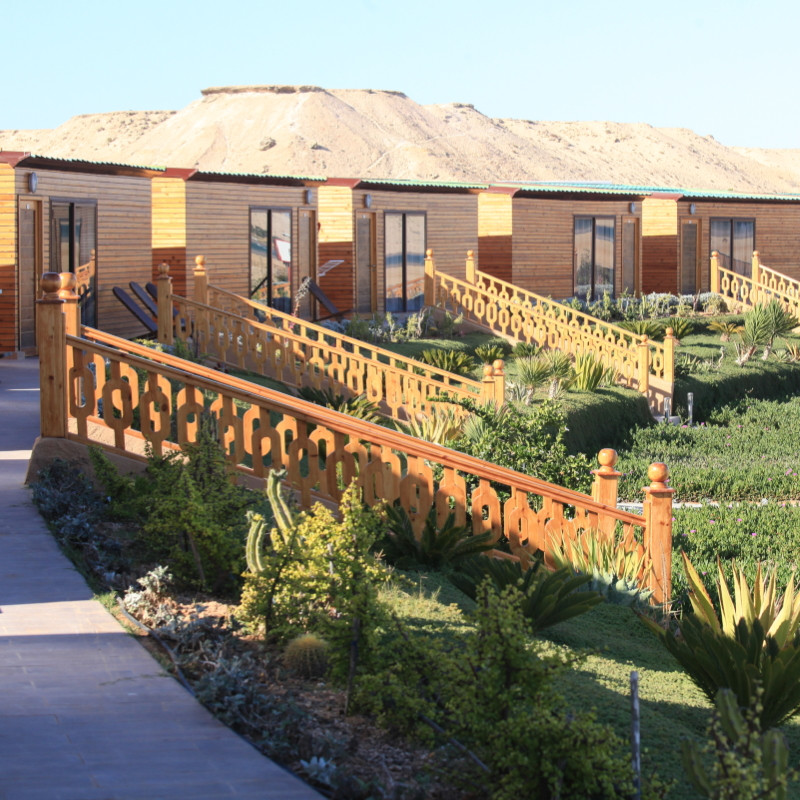
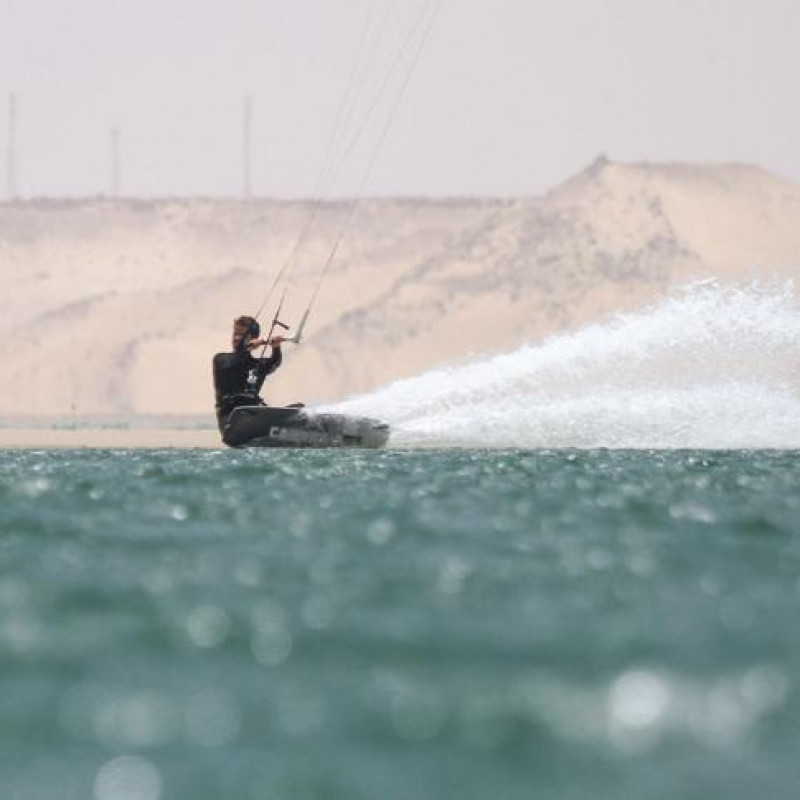
 Overall Rating
Overall Rating Beginner Friendly
Beginner Friendly Wind quality
Wind quality Non-kiting activities
Non-kiting activities Nightlife
Nightlife
